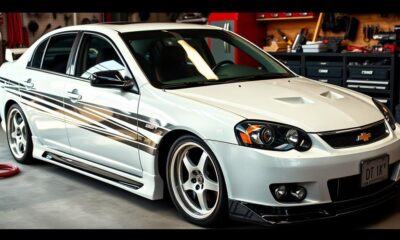Tesla Tuning
Can You Charge a Tesla in the Rain? The Truth About EV Safety!
Knowing whether you can charge a Tesla in the rain is crucial for EV owners—discover the surprising truth about safety and charging conditions!

Yes, you can charge your Tesla in the rain. Modern charging systems are designed with safety in mind. Weatherproof chargers and sealed connections help prevent electric shock. They come with GFCI protections that cut off power if water is detected, ensuring your safety. Many drivers have successfully charged their vehicles in wet conditions without issues. However, it's smart to avoid charging in severe rain and seek a sheltered spot when possible. Maintaining a towel to dry off the connections can also help enhance your experience. Want to know more about how to charge safely during storms?
Key Takeaways
- Charging a Tesla in the rain is generally safe due to advanced weatherproof technology and compliance with safety standards.
- Weatherproof connectors and sealed charging ports prevent water ingress, minimizing the risk of electrical shock.
- Electric Vehicle Supply Equipment (EVSE) includes GFCIs that disconnect power upon detecting water, enhancing safety during wet conditions.
- Many Tesla owners report positive experiences charging in the rain, as concerns about battery health in wet conditions are largely unfounded.
- Best practices include avoiding severe rain and using dedicated charging stations designed for outdoor use to ensure safe charging.
Safety of Charging in Rain
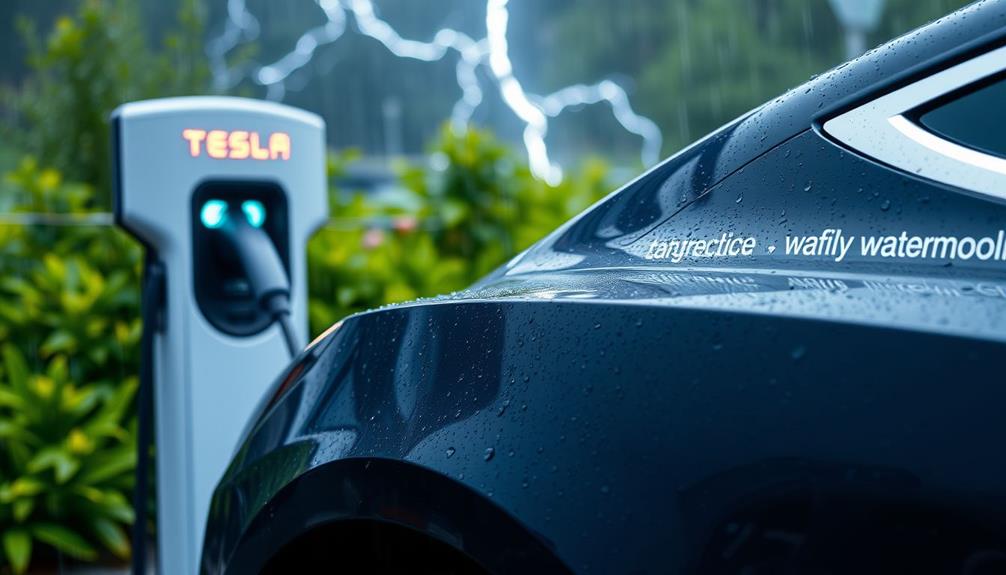
Charging your electric vehicle in the rain is generally safe, thanks to advanced technology designed to protect you. Electric vehicles (EVs), including Teslas, come equipped with weatherproof chargers that prevent electrical shock. These chargers comply with rigorous safety standards, guaranteeing you can charge your car without worry, even during storms.
The electric vehicle supply equipment (EVSE) features ground fault circuit interrupters (GFCIs) that automatically disconnect power if they detect water ingress. This crucial safety feature adds additional peace of mind while you're charging in the rain.
Furthermore, the charging ports on Teslas and other electric vehicles are sealed and insulated, effectively blocking water from reaching critical components.
Manufacturers put EV charging systems through extensive testing, including fire hose testing for waterproofing, to assure reliability in adverse weather. Federal law mandates that electric vehicle chargers meet consumer product safety standards, guaranteeing these systems are safe for use in all conditions.
Technology Behind Charging Systems

Electric vehicle charging systems are built with advanced technology to guarantee safety and reliability, especially in challenging weather conditions. These systems feature weatherproof connectors that are rigorously tested, including fire hose testing, to verify they can withstand inclement weather.
The incorporation of Ground Fault Circuit Interrupter (GFCI) protection automatically disconnects power during a ground fault, minimizing electrical hazards when it rains.
Moreover, the Electric Vehicle Supply Equipment (EVSE) guarantees that high voltage isn't delivered until secure connections are established, further reducing the risk of electrocution.
You'll find that charging cables and connectors are engineered to endure harsh conditions, equipped with weatherproof enclosures and seals that prevent water ingress, which could otherwise lead to short circuits.
Manufacturers take safety seriously, conducting thorough testing to confirm that charging systems maintain functionality and safety in various environmental conditions, including rain and humidity.
These safety features are a vital part of the design, ensuring that you can charge your electric vehicle without worry, even when the weather isn't cooperating.
With these robust technologies, you can trust that your charging experience will be safe and reliable, rain or shine.
User Experience in Wet Conditions

Many drivers have reported positive experiences while charging their electric vehicles in the rain, highlighting that modern technology effectively guarantees safety and efficiency.
As a Tesla owner, you can charge your vehicle confidently, knowing that the charging ports are weatherproof and designed to prevent electric shock, even in wet conditions.
User education on charging safety plays a crucial role, as real-life experiences demonstrate that most EVs function reliably in inclement weather.
While some might worry about battery health after exposure to rain, the consensus is that these concerns are largely unfounded.
Here are a few tips to enhance your user experience while charging your Tesla in the rain:
- Choose covered charging locations when possible.
- Regularly inspect your charging equipment for signs of wear.
- Stay informed about local charging station conditions.
- Familiarize yourself with your vehicle's safety requirements.
Environmental Impact of Rain Charging

Utilizing rain for charging not only keeps your electric vehicle ready for the road but also offers significant environmental benefits. When you charge your EV during wet weather, you can tap into renewable energy sources like solar panels at charging stations. This practice helps reduce the carbon emissions typically associated with electricity generation, enhancing your vehicle's overall environmental impact.
Moreover, the increased adoption of rain-compatible charging infrastructure promotes lower greenhouse gas emissions, which is vital for climate change mitigation. Some charging stations even implement rainwater harvesting systems, using collected rainwater for maintenance and irrigation.
By charging during storms, you can also help stabilize the electrical grid, as lower electricity demand often coincides with your charging needs.
It's important to remember that charging your electric vehicle in various weather conditions remains safe. Charging stations are designed with measures to guarantee you're protected from electrical shock, allowing you to enjoy the benefits of rain charging without concerns.
Best Practices for Safe Charging
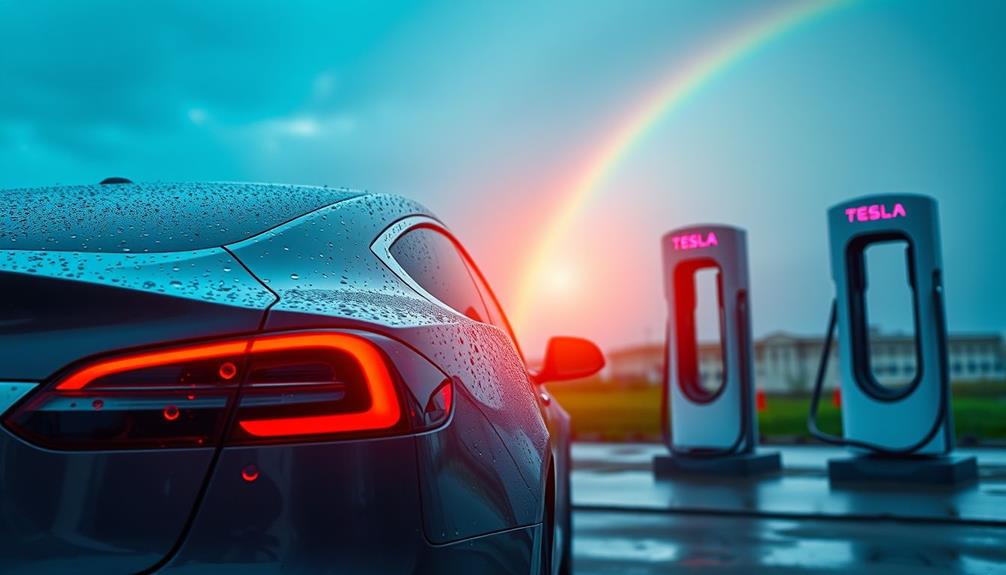
When charging your electric vehicle, it's important to prioritize safety, especially in rainy conditions. To guarantee it's safe to charge your Tesla or any electric car during bad weather, follow these best practices:
- Always use Electric Vehicle Supply Equipment (EVSE) that meets safety standards.
- Avoid charging in severe rain; seek sheltered locations instead.
- Carry a towel to wipe down the charging plug and vehicle input before and after charging.
- Verify charging cables aren't exposed to standing water or puddles.
These steps help protect your EV batteries from moisture-related issues. Regularly inspect and maintain your charging equipment to check for waterproof seals and proper functionality.
Additionally, if you're using a dedicated charging station, confirm it's designed for outdoor use and capable of handling wet conditions.
By taking these precautions, you greatly reduce the risks associated with charging your vehicle in inclement weather.
Remember, while it's generally safe to charge in the rain, being proactive about your charging port and connection can prevent potential hazards.
Stay safe and enjoy your electric car experience, rain or shine!
Frequently Asked Questions
Is It Safe to Charge a Tesla While Raining?
Yes, it's safe to charge your Tesla while it's raining. The charging ports are designed to withstand wet conditions, and safety features like GFCI protect against any electrical issues. Just avoid charging during severe storms.
Is It Safe to Charge EV While Raining?
Charging an EV in the rain might seem risky, but it's actually safe. The equipment's designed to keep you secure, preventing any issues. Just guarantee everything's properly connected, and you're good to go, rain or shine!
Is It Safe to Charge a Tesla During a Thunderstorm?
Charging a Tesla during a thunderstorm is generally safe. Modern systems protect against electrical hazards, and the risk of shock is minimal. Just guarantee your equipment is well-maintained and avoid charging in extremely severe conditions.
How to Protect a Tesla Charger From Rain?
Did you know that 80% of EV charging occurs at home? To protect your Tesla charger from rain, use a wall-mounted charger, keep connectors dry, and consider protective covers to minimize moisture exposure.
Conclusion
Charging your Tesla in the rain isn't just safe; it's as reliable as a sunny day. With advanced technology designed to handle wet conditions, you can plug in without worry. Just keep a few best practices in mind, like using a covered area when possible. So, go ahead and charge up, even when the clouds roll in. After all, you can't let a little rain dampen your electric ride!
Alex is our go-to expert on performance tuning, with over a decade of experience in the automotive industry. His deep understanding of engine dynamics, exhaust systems, and performance software allows him to break down complex concepts into easy-to-follow guides. Whether you’re looking to boost horsepower or fine-tune your vehicle’s responsiveness, Alex’s insights will help you achieve peak performance.
Tesla Tuning
How Much Do Tesla Batteries Cost? Uncover the True Price of Power!
How much do Tesla batteries really cost? Discover the surprising factors that influence pricing and what it means for your electric vehicle investment.
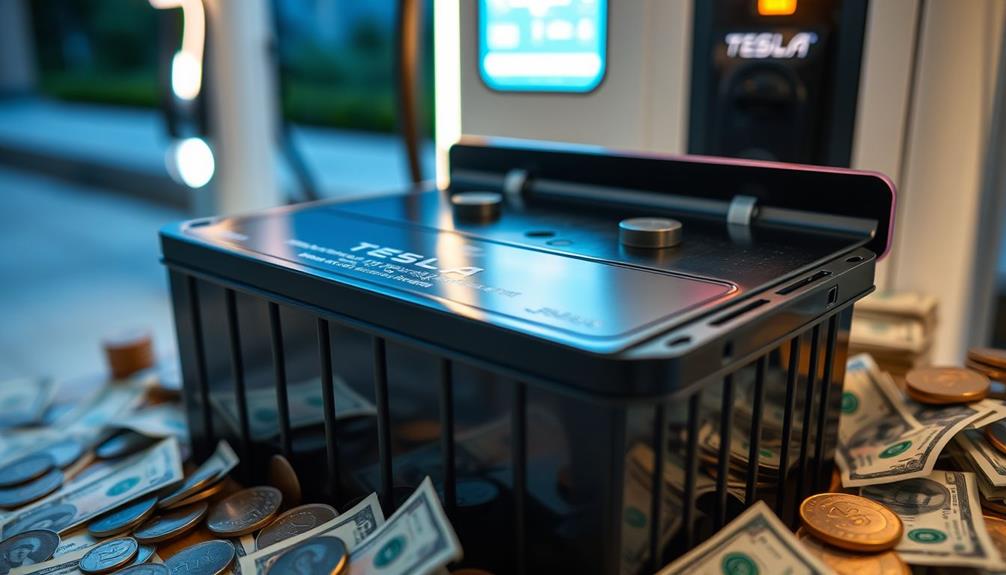
Tesla battery costs range from about $5,000 to over $28,000, varying by model and specific features. For instance, replacing a Model S can run you between $12,000 to $15,500, while the Model 3 averages around $13,000. Labor costs also factor in, adding another $525 to $2,600 to the total. Market demand for materials like lithium and nickel can influence these prices too. If you want to get the most out of your investment and explore options, there's much more to uncover about battery lifespan and maintenance strategies you might find helpful.
Key Takeaways
- Replacement costs for Tesla batteries vary by model, ranging from $5,000 to $28,000 based on specifications and type.
- Model S battery replacements typically cost between $12,000 and $15,500, while Model 3 averages around $13,000.
- Labor costs for battery replacement can add an additional $525 to $2,600 to the overall expense.
- Battery lifespan ranges from 10 to 20 years, with warranties covering up to 150,000 miles for Model S/X and 100,000 miles for Model 3/Y.
- Market demand for minerals like lithium and nickel influences battery costs, causing potential price fluctuations over time.
Tesla Battery Replacement Costs

When it comes to replacing a Tesla battery, costs can vary greatly depending on the model and other factors. For a Model S battery replacement, you're looking at an estimated cost ranging from $12,000 to $15,500, with total replacement costs potentially hitting $20,000 to $22,000.
If you own a Model 3, battery replacement costs start around $13,500, with estimates reaching up to $28,000 based on battery size and specifications. The Model Y battery replacement costs align closely with the Model 3, averaging around $15,000 for a new battery pack.
Labor costs at Tesla service centers can also greatly impact the total cost, which typically ranges between $175 to $200 per hour. Additionally, replacement costs can fluctuate based on market conditions, battery age, and specific model type.
In some cases, you might find costs as low as $5,000 to $7,000 if circumstances align favorably. Understanding these Tesla battery replacement costs can help you make informed decisions about your vehicle's battery life and warranty coverage, ensuring you're prepared for any necessary expenses down the road.
Factors Influencing Battery Prices
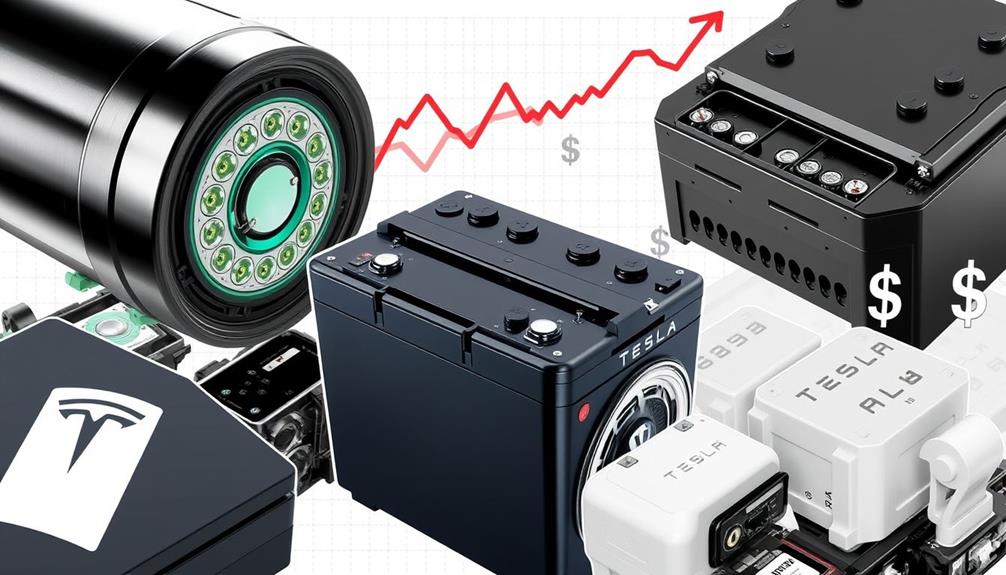
When you're looking at Tesla battery prices, you'll notice that specific models can markedly affect costs.
The battery's capacity also plays a big role, as larger batteries generally come with a higher price tag.
Plus, market demand for essential materials like nickel and lithium can influence what you'll pay when it's time for a replacement.
Model Specific Pricing
Tesla battery replacement costs vary greatly across models, influenced by several key factors. For instance, the estimated cost of a Tesla battery for the Model S battery replacement ranges from $12,000 to $15,500. In contrast, the Model 3 battery replacement typically sits around $13,500.
Meanwhile, the Model X battery replacement costs can exceed $13,900, while the Model Y battery cost is estimated at approximately $10,500 to $11,400.
Labor costs for battery replacement also play a significant role in the overall expenses. These costs generally range from $175 to $200 per hour, leading to total labor costs amounting to $525 to $2,600 for a complete replacement.
Additionally, battery size and capacity greatly affect the pricing of Tesla batteries; larger batteries usually incur higher replacement costs due to their advanced technology and greater range.
Lastly, market trends for EV batteries, including the demand for essential minerals like nickel, cobalt, and lithium, can further influence the pricing of Tesla batteries across different models.
Understanding these factors can help you prepare for potential battery replacement costs.
Battery Capacity Impact
Battery capacity markedly influences the pricing of Tesla batteries, making it a key factor to contemplate. Larger kWh packs translate to higher Tesla battery replacement costs, as they offer increased range and energy storage. Here's a quick comparison of replacement costs across different models:
| Model | Battery Capacity (kWh) | Replacement Cost ($) |
|---|---|---|
| Model S | 100 | 12,000 – 15,000 |
| Model 3 | 75 | ~13,000 |
| Model Y | 75 | ~15,000 |
| Model X | 100 | 15,000 – 22,000 |
| Model 3 Long Range | 82 | ~15,000 |
The Model S, with its higher capacity, can have replacement expenses reaching up to $22,000. In contrast, the average cost for a Model 3 battery stands at around $13,000. Similarly, the Model Y's costs are expected to align with those of the Model 3. Keep in mind that market conditions and the demand for essential minerals like lithium, nickel, and cobalt also notably impact overall battery costs.
Market Demand Influence
The rising demand for electric vehicles has put considerable pressure on the market for essential minerals like nickel, cobalt, and lithium, which are critical for Tesla batteries. This increased market demand drives up replacement costs, often ranging from $5,000 to $20,000, with the average cost for a Model 3 sitting around $13,000.
As more consumers turn to EVs, the demand for these batteries surges, leading to pricing fluctuations and potential shortages. Battery degradation over time and your driving habits can influence when you'll need a replacement, often resulting in higher costs for out-of-warranty replacements.
The scarcity of key minerals like lithium and cobalt plays an important role in this equation, as their prices can vary greatly based on global supply and demand dynamics.
However, the landscape is shifting. The emergence of third-party options for battery replacements is creating competitive pricing dynamics. This could potentially lower your replacement costs in the future, making Tesla batteries more accessible as the market evolves.
Ultimately, understanding these factors can help you navigate the complexities of battery pricing in the ever-growing electric vehicle market.
Warranty Coverage for Tesla Batteries

When you invest in a Tesla, you gain peace of mind with its robust battery warranty coverage. Tesla offers an 8-year warranty that varies by model. For the Model S and Model X, you get coverage for up to 150,000 miles, while the Model 3 and Model Y are covered for up to 100,000 miles.
This warranty protects you against significant capacity degradation, ensuring that if your battery's capacity drops below 70% during the coverage period, Tesla will replace it at no cost.
The warranty also covers manufacturing defects and premature aging, so you can drive confidently knowing you're protected. However, keep in mind that external damages or improper maintenance might void this coverage.
One standout feature is that the warranty is transferable to subsequent owners, adding value to your vehicle. This means if you decide to sell your Tesla, the new owner will also benefit from the same battery performance guarantees, enhancing your car's resale potential.
Battery Lifespan and Performance

When you own a Tesla, understanding battery lifespan and performance is essential.
Your driving habits, maintenance, and even the climate can greatly affect how long your battery lasts and how well it performs.
Battery Lifespan Factors
Understanding the factors that influence battery lifespan can greatly enhance your Tesla ownership experience. Tesla batteries are designed to last between 10 to 20 years, typically covering 300,000 to 500,000 miles. However, several elements can impact this longevity.
| Factor | Impact on Battery Lifespan |
|---|---|
| Driving Habits | Aggressive driving can shorten lifespan due to higher energy demands. |
| Environmental Conditions | Extreme temperatures can degrade battery performance. |
| Maintenance Practices | Regular check-ups at Tesla service centers can extend battery life. |
Your driving habits play an essential role; smooth, efficient driving enhances battery performance. Environmental conditions, like temperature fluctuations, also affect battery retention. Maintaining at least 70% battery retention guarantees warranty eligibility for battery replacement after 8 years or 100,000-150,000 miles, depending on your model.
Lastly, higher kilowatt-hour (kWh) capacity batteries provide increased range, contributing to a better driving experience. By being mindful of these factors, you can maximize your Tesla battery's lifespan and overall performance.
Performance Impact Elements
Tesla's battery performance is closely tied to various elements that can greatly enhance or diminish your driving experience. One major factor is battery health, which directly affects your vehicle's efficiency and driving range.
With proper maintenance practices and regular check-ups at a Tesla service center, you can monitor your battery's condition and guarantee it performs at its best throughout its lifespan.
Your driving habits also play an important role. Aggressive acceleration or frequent supercharging can lead to battery degradation, impacting overall performance.
Similarly, the frequency of supercharging affects battery health; while it's convenient, over-reliance on fast charging can shorten your battery's lifespan.
Tesla batteries typically last between 10 to 20 years, maintaining over 70% capacity after 8 years, but that can vary based on how you drive and care for your vehicle.
Higher kWh capacity batteries, like those in the Model S and Model Y, offer extended driving ranges, which can enhance your performance experience.
Replacement Options and Services

Battery replacement for your Tesla can be handled through various options, each with its own pros and cons. You can choose to go to Tesla service centers, which offer specialized expertise but may come with higher battery replacement costs.
For instance, replacing the battery in a Model 3 averages around $13,000, with costs ranging from $5,000 to $20,000 depending on the model.
If you're looking for lower prices, third-party shops might be a viable alternative. However, keep in mind that they often lack the specialized knowledge required for complex repairs on Tesla vehicles.
While scheduling your service through the Tesla app can simplify the process, it's important to weigh your options carefully.
For the more adventurous, DIY battery replacement is possible, but it's not recommended unless you have solid technical expertise. The complexity of the task can lead to potential issues down the line if not executed properly.
Ultimately, your choice of replacement option will depend on your budget, comfort level with repairs, and the importance you place on specialized care for your Tesla.
Tips to Extend Battery Life

Maintaining your Tesla's battery health is just as important as knowing your replacement options. To enhance battery longevity and extend your battery lifespan, follow a few simple tips.
First, store your Tesla in a garage to protect it from extreme temperature fluctuations, which can severely impact performance.
Next, pay attention to your charging habits. Keep your battery's charge level between 20% and 80% to minimize stress and reduce battery degradation. Frequent full discharges can lead to faster capacity fade, so it's best to avoid them.
Whenever possible, opt for home charging instead of relying on DC Fast Charging, as rapid charging can accelerate battery wear.
Monitor your battery's health regularly through the Tesla app, and don't hesitate to schedule check-ups at service centers to catch any issues early.
Additionally, reducing cargo weight and choosing flat driving routes can improve energy efficiency, which ultimately decreases the strain on your battery during operation.
Frequently Asked Questions
What Percentage of a Tesla Cost Is the Battery?
The battery accounts for about 30% to 40% of your Tesla's total cost. Depending on the model, this percentage can fluctuate, considerably impacting the overall price you pay for your electric vehicle.
How Much Does a Tesla 100 Kwh Battery Cost?
If you're seeking specifics, a Tesla 100 kWh battery typically costs between $13,900 and $15,500. Total expenses, including labor and parts, can escalate to around $20,000 to $28,000, depending on various factors.
What Is the Life Expectancy of a Tesla Battery?
Tesla batteries typically last between 10 to 20 years, depending on your driving style and environmental factors. With proper care, you can enjoy a battery that retains over 70% capacity even after eight years.
Is the Battery the Most Expensive Part of Tesla?
Think of your Tesla as a high-tech orchestra; the battery's the conductor. Yes, the battery's the most expensive part, driving performance and range, but its longevity and efficiency make it worth every penny in the long run.
Conclusion
So, there you have it—Tesla batteries might cost a pretty penny, but who needs a bank account anyway? Just think of it as investing in a fancy paperweight that runs on dreams and sunshine! With warranties and service options, you're basically covered, right? Just remember, the secret to longevity isn't just in the battery; it's in your ability to keep your wallet open. After all, who wouldn't want to keep the dream of electric luxury alive—at any cost?
Alex is our go-to expert on performance tuning, with over a decade of experience in the automotive industry. His deep understanding of engine dynamics, exhaust systems, and performance software allows him to break down complex concepts into easy-to-follow guides. Whether you’re looking to boost horsepower or fine-tune your vehicle’s responsiveness, Alex’s insights will help you achieve peak performance.
Tesla Tuning
Tesla Charging Costs: What You Need to Know Before Plugging In!
Get ready to uncover the surprising costs of charging your Tesla and discover how you can save money with smart choices!

When you plug in your Tesla, it's essential to understand charging costs to save money. Home charging usually costs between $8.28 and $14.40 per full charge, while Supercharger fees range from $6 to over $50, depending on where you are and the time of day. Charging at home is generally more affordable than gas, averaging monthly costs between $36 and $53. Keep in mind that local electricity rates and charging methods can impact your overall expenses. There's a lot more to explore about optimizing your Tesla charging experience, including potential savings with solar energy.
Key Takeaways
- Home charging costs for a Tesla Model 3 typically range from $8.28 to $14.40 per full charge, depending on local electricity rates.
- Supercharger fees vary widely, costing between $0.11 to $0.60 per kWh, resulting in total charges between $6.01 and $32.78.
- Charging efficiency is estimated at 90%, meaning you'll need to account for extra kWh beyond what your bill reflects.
- Utilizing solar energy can significantly reduce charging costs to as low as $0.06 per kWh, leading to greater savings.
- Monthly Tesla charging costs range from $36 to $53, making it more affordable compared to the average gas vehicle expense of $143.
Understanding Charging Costs
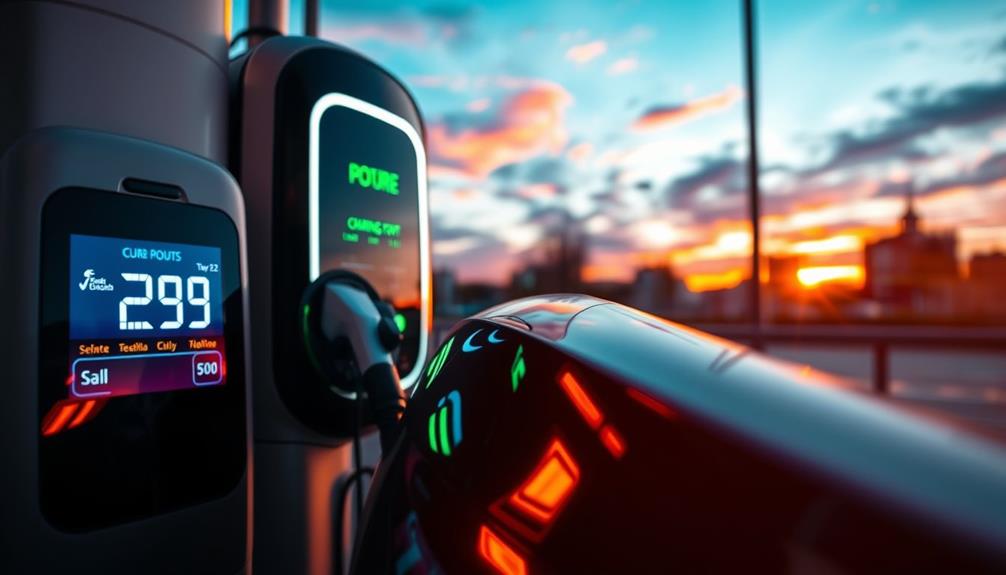
When you're considering the costs of charging your Tesla, it's essential to understand the various factors that influence your expenses. Charging your Model 3 at home typically costs between $8.28 and $14.40 for a full charge, depending on your local electricity rates.
If you opt for a Supercharger, be aware that fees can vary greatly, with costs per kWh ranging from $0.11 to $0.60. This can lead to average charging costs between $6.01 and $32.78, depending on your charging habits.
Charging efficiency also plays a role in your total expenses, as it's estimated at around 90%. This means you'll need more kWh for a full charge than what's reflected in your bill due to energy loss during charging.
Additionally, your location is a key factor; states like California and Hawaii have remarkably higher electricity rates, which can increase your overall charging expenses.
On average, you can expect your monthly charging costs to range between $36 and $53, making it a more affordable option compared to fueling a gas-powered vehicle.
Understanding these factors will help you budget effectively for your Tesla's charging costs.
Home Charging Expenses
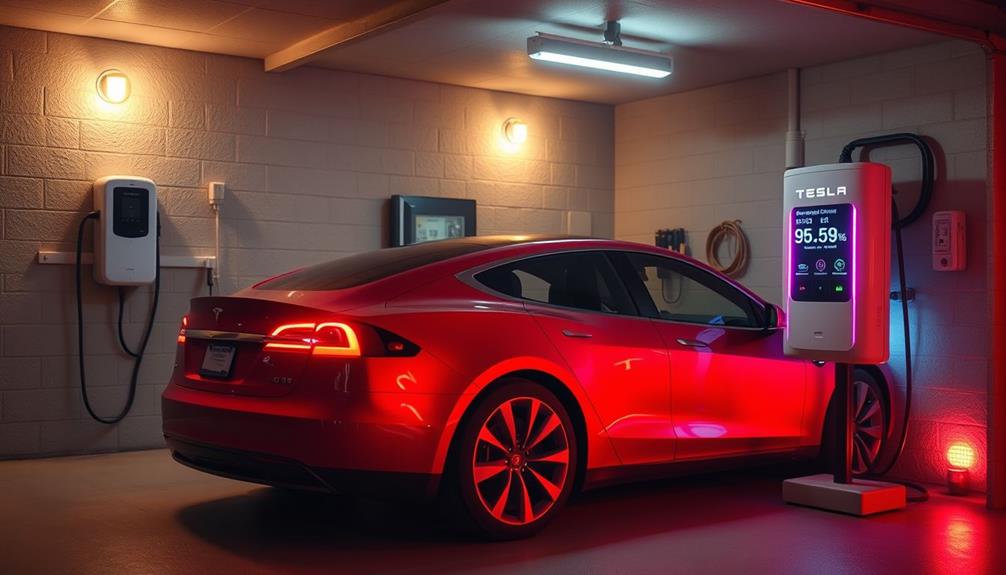
Charging your Tesla at home can be a smart way to save on expenses, thanks to more favorable electricity rates. On average, home charging costs range from $8.28 to $14.40, depending on your Tesla model and local electricity rates. By taking advantage of off-peak hours, you can greatly reduce your charging costs compared to public stations.
To maximize efficiency, consider installing a Level 2 outlet, which can deliver up to 30 miles of range per hour. This is a big difference compared to a standard outlet, which only offers 2-3 miles of range per hour.
While installation costs for a home charging station typically range from $750 to $1,500, there may be available incentives that can help offset these expenses.
It's a good idea to plug in every evening to top off the battery and set a charging schedule that aligns with lower electricity rates. By doing this, you not only save money but also guarantee your Tesla is ready to go whenever you are.
Embracing home charging can be a convenient and economical choice for Tesla owners.
Supercharger Pricing Structure
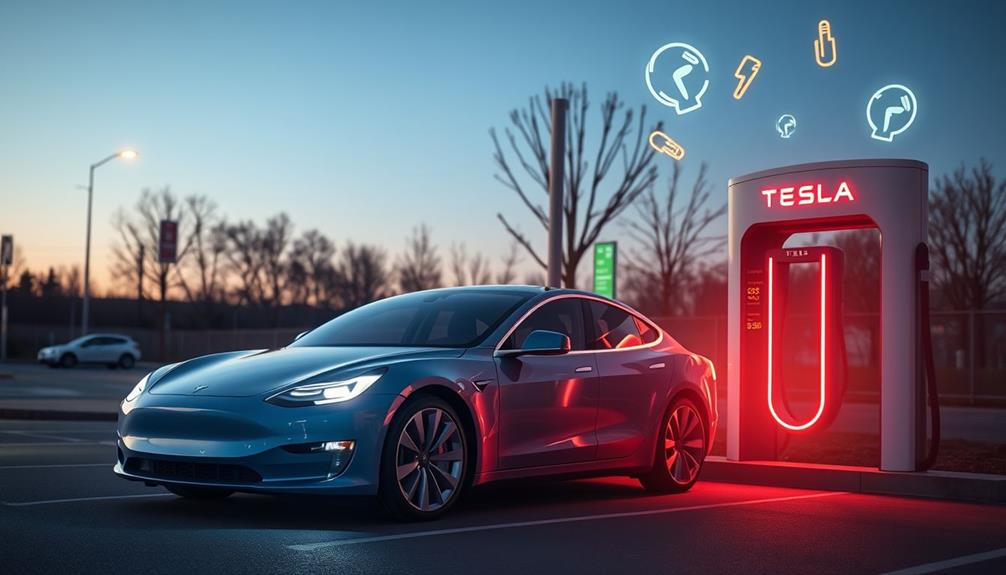
For Tesla owners who need to charge on the go, understanding the Supercharger pricing structure is key to managing expenses. Supercharger pricing varies by location, with costs typically ranging from $0.25 to $0.50 per kWh. Depending on the station's pricing model, you might pay charging fees either per kWh or per minute.
Keep in mind that charging speed can also influence how quickly you fill your battery and, consequently, your overall costs.
Be aware of idle fees, which kick in if your vehicle remains parked after reaching a full charge. These fees start at $0.50 per minute and double once the station hits full capacity.
At busy Supercharger locations, congestion fees may apply as your charging session nears completion, although the first five minutes after charging are fee-free.
Additionally, Supercharging rates can fluctuate based on the time of day, with higher costs during peak hours.
To save money, try to plan your charging sessions during off-peak periods and remain aware of the cost per minute and per kWh, so you can keep your charging expenses in check.
Factors Influencing Charging Fees
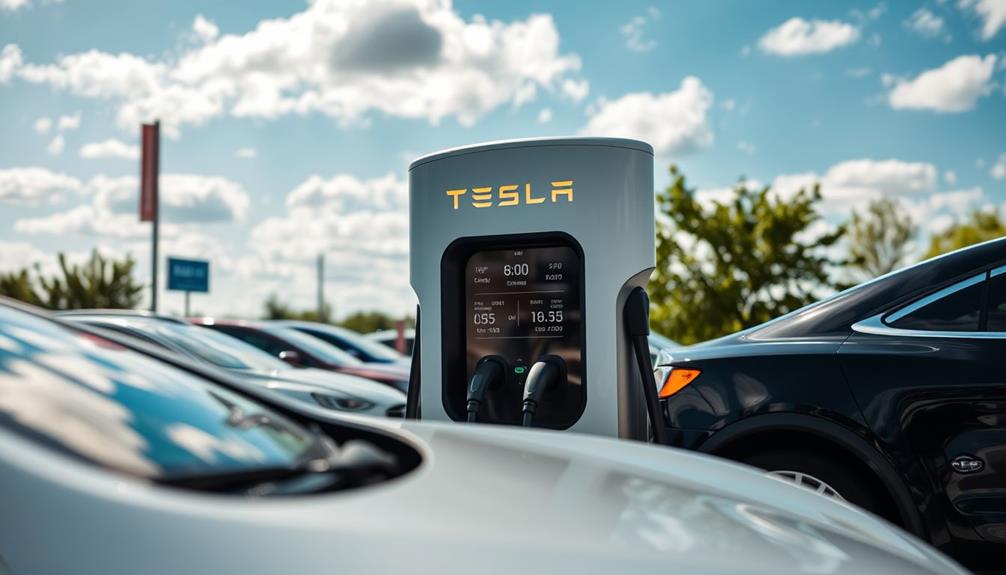
Understanding the nuances of charging fees is essential for Tesla owners looking to optimize their expenses. Several factors influence your charging costs, starting with local electricity rates, which average around $0.16 per kWh in the U.S. Depending on your region, this can greatly impact your total cost to fully charge your vehicle.
The battery size of your Tesla vehicles also plays a vital role; with capacities ranging from 57.5 kWh to 100 kWh, you could spend anywhere from $5 to $30 for a full charge.
Home charging is typically more economical, often costing less than $0.10 per kWh compared to Supercharger costs, which range from $0.25 to $0.50 per kWh. Your driving habits matter too; if you have shorter commutes, you'll likely face lower charging needs and costs. Conversely, long-distance travel can increase your expenses.
Additionally, don't overlook the seasonal climate. Cold temperatures can reduce battery efficiency, leading to more frequent charging sessions and higher costs. By being mindful of these factors, you can make informed decisions to manage your Tesla charging expenses effectively.
Benefits of Solar Charging
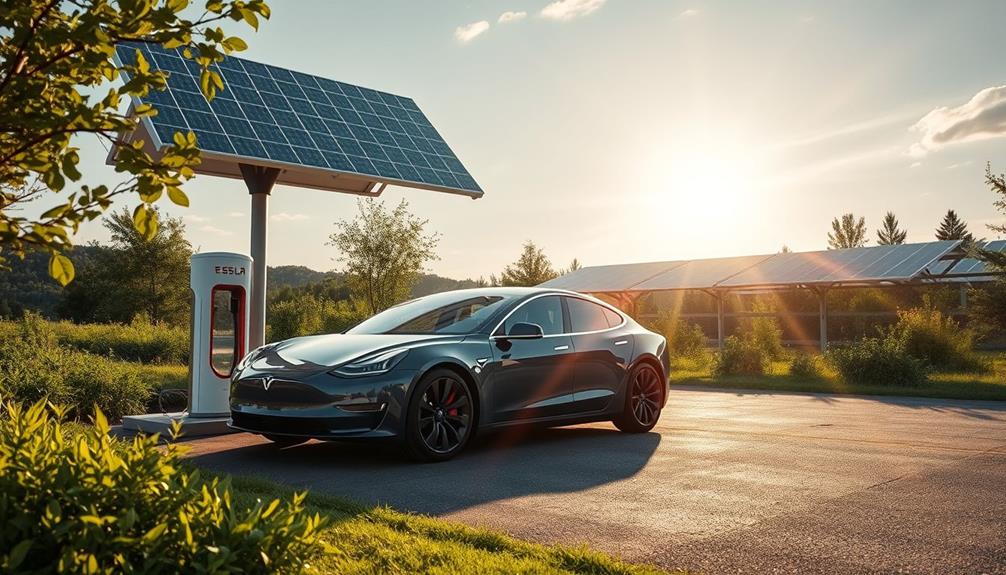
Switching to solar charging can greatly cut your Tesla's energy costs. By harnessing solar energy, you can reduce costs markedly, with an estimated charging cost of only $0.06 per kWh compared to traditional utility rates.
This means that the average charging costs for your Tesla could range from just $3.11 to $5.40, resulting in substantial savings over conventional charging methods.
Installing a solar system typically costs around $19,000, but you could see a return on investment (ROI) in as little as five years through these reduced charging costs.
Just five solar panels can cover your Tesla's charging needs, allowing for efficient energy generation that powers your vehicle while cutting down on expenses.
Beyond financial savings, solar charging enhances environmental sustainability by reducing reliance on fossil fuels for electricity generation.
You'll not only enjoy lower charging costs but also contribute to a greener planet.
With improved charging efficiency and lower utility rates, embracing solar energy is a smart choice for both your wallet and the environment.
Comparing Tesla and Gas Costs

When you stack up Tesla charging costs against fueling a gas-powered vehicle, the difference is striking. Charging your Tesla typically costs between $36 to $53 per month, while the average gas vehicle owner spends around $143 monthly on fuel.
At home, charging a Tesla in 2024 ranges from $8.28 to $14.40, considerably less than the average gas price of $3.48 per gallon.
If you decide to use Supercharger stations, expect to pay between $6 and over $50, depending on the location. However, home charging remains the most economical option, costing only $0.10 to $0.30 per kWh.
Over 13,500 miles, Tesla's annual charging costs can range from $405 to $1,755, which is remarkably lower than the fuel costs for gas vehicles over the same distance.
Moreover, if you harness solar panels for charging, you can reduce your electricity cost to around $0.06 per kWh, making Tesla ownership even more appealing.
To summarize, the financial benefits of driving an electric vehicle like a Tesla are clear when you compare charging and fuel costs.
Frequently Asked Questions
How to Use a Tesla Charger for the First Time?
To use a Tesla charger for the first time, locate the charge port, plug in the connector until it clicks, and monitor your charging status on the touchscreen. Disconnect once charging's complete, and enjoy your drive!
How Much Does It Cost to Fully Charge a Tesla at a Charging Station?
Charging a Tesla can cost between $6 and $57, depending on the model and location. Keep in mind that idle fees and congestion charges might apply, adding to your total expense if you're not careful.
What Do I Need to Know About Charging My Tesla at Home?
When charging your Tesla at home, you'll enjoy convenience and savings. Consider installing a Level 2 charger for faster charging speeds, and plug in every night to keep your battery topped off efficiently.
Do You Have to Pay to Charge Your Tesla at a Charging Port?
Oh, sure! Just plug in your Tesla and hope for free unicorn energy! Unfortunately, you'll actually have to pay at charging ports, so budget wisely and prepare for some electric surprises along the way.
Conclusion
In a world where every penny counts, understanding Tesla charging costs can really charge up your savings. By knowing the ins and outs of home charging, Supercharger fees, and the perks of solar energy, you can make informed choices that fit your budget. Just like a well-tuned engine, your electric journey can run smoothly and efficiently. So, plug in and power up your wallet while enjoying the ride—it's a win-win for your finances and the planet!
Alex is our go-to expert on performance tuning, with over a decade of experience in the automotive industry. His deep understanding of engine dynamics, exhaust systems, and performance software allows him to break down complex concepts into easy-to-follow guides. Whether you’re looking to boost horsepower or fine-tune your vehicle’s responsiveness, Alex’s insights will help you achieve peak performance.
Tesla Tuning
Who Is Nikola Tesla? The Man Behind the Name!
A visionary inventor, Nikola Tesla revolutionized electrical engineering, but what secrets and struggles lay behind his genius? Discover the man behind the name!

Nikola Tesla, born on July 10, 1856, was a brilliant inventor and electrical engineer who changed the world with his work in alternating current (AC) technology. You might know him for his contributions to modern electricity, including the Tesla coil and the AC induction motor. After an early career marked by disputes with Thomas Edison, he showcased the superiority of AC at the 1893 World's Columbian Exposition. Despite facing financial struggles and competition, his innovations laid the groundwork for our contemporary electrical systems. There's so much more to his incredible journey that you'll find fascinating!
Key Takeaways
- Nikola Tesla was a Serbian-American inventor born on July 10, 1856, known for developing the alternating current (AC) power system.
- He worked for Edison Machine Works but resigned due to disputes over AC vs. DC technology and financial disagreements.
- Tesla patented the AC induction motor in 1888, revolutionizing electrical engineering and enabling self-starting electric motors.
- He created the Tesla coil in 1891, which became essential for wireless communication and radio transmission.
- Tesla held over 300 patents and his legacy endures through the SI unit "tesla," symbolizing his impact on technology.
Early Life and Education

Nikola Tesla's early life was marked by a unique blend of cultural influences and intellectual prowess. Born on July 10, 1856, in Smiljan within the Austrian Empire, he was raised in a Serbian Orthodox family, which instilled in him a deep appreciation for education and innovation.
From a young age, you'd notice his eidetic memory, enabling him to visualize complex concepts and inventions in remarkable detail. In pursuit of knowledge, he attended primary school in Smiljan before moving to Gospić for further studies.
By 1873, you'd see him graduate high school with a strong focus on mathematics and physics. His passion for these subjects led him to the Polytechnic Institute in Graz, Austria, where he began studying engineering and physics on a scholarship.
However, despite his brilliance, he faced academic struggles and left without completing his degree. After departing Graz in December 1878, Tesla worked as a draftsman in Maribor, earning 60 florins a month.
This experience fueled his growing interest in electrical engineering, setting the stage for a remarkable career that would transform the world.
Career Beginnings

You'll find that Nikola Tesla's career took off in 1881 at the Budapest Telephone Exchange, where he first honed his skills in electrical engineering.
Just a few years later, he moved to the United States and joined Edison Machine Works, aiming to improve electrical systems.
However, his time there was short-lived due to conflicts with Edison, setting the stage for his future innovations.
Early Employment Opportunities
Starting his career at the Budapest Telephone Exchange in 1881, Tesla developed a strong interest in electrical engineering and telephony.
In 1882, he moved to Paris to work for the Continental Edison Company, where he gained practical experience in electric lighting and systems. This opportunity allowed him to deepen his understanding of electrical technologies, setting the stage for his future innovations.
In June 1884, Nikola Tesla emigrated to the United States and joined Edison Machine Works in New York City. Here, he faced a competitive environment that challenged his skills and ideas.
Despite his talent, Tesla's time at Edison was marked by unresolved bonus disputes and differing views on technology, particularly regarding the merits of AC systems versus Edison's preferred DC systems.
After a brief tenure, Tesla resigned from Edison Machine Works, determined to pursue his vision independently.
In 1885, he sought investors and founded the Tesla Electric Light Company. This marked the beginning of his journey into independent inventions, paving the way for groundbreaking advancements in electrical engineering that would soon follow.
Edison Collaboration Experience
After establishing his foundation in electrical engineering, Tesla's move to the United States brought him to Edison Machine Works in New York City. Here, he honed his advanced engineering skills, quickly catching Edison's attention with his talent for designing improved dynamos and motors.
This collaboration, however, lasted only six months. Tesla and Edison had differing business philosophies, and unresolved disputes over promised bonuses soured their working relationship.
During his time at Edison, Tesla developed an innovative arc lamp-based street lighting system, but unfortunately, his designs never saw production. Frustrated by this lack of recognition and opportunity, he decided to resign and seek better prospects.
This pivotal moment marked the beginning of Tesla's journey towards independence in the engineering world.
After leaving Edison, Tesla sought investors for his groundbreaking ideas, which ultimately led to the creation of the AC induction motor. This innovation would spark a fierce rivalry with Edison's direct current system, setting the stage for one of the most significant battles in electrical engineering history.
Tesla's experiences at Edison Machine Works were essential in shaping his future endeavors and revolutionary contributions.
Innovations and Inventions

Nikola Tesla's groundbreaking innovations and inventions have fundamentally shaped modern technology and electrical systems. As an inventor, Nikola Tesla revolutionized the way we generate and use electricity. His contributions aren't just historical; they're the backbone of today's electrical infrastructure.
Here are some key innovations:
- Developed the AC electricity system, which is now the global standard.
- Patented the polyphase induction motor in 1888, allowing for self-starting electric motors.
- Created the Tesla coil, essential for wireless communication and radio transmission.
- Designed one of the first AC hydroelectric power plants at Niagara Falls.
These inventions illustrate Tesla's genius. His AC electricity system not only transformed electrical circuits but also enabled large-scale power generation through hydroelectric power. The polyphase induction motor made electric drives more efficient, while the Tesla coil paved the way for advancements in wireless technology.
With over 300 patents, Tesla's work in radar, X-ray technology, and remote control systems further cements his legacy as a visionary. His contributions continue to influence how we live and connect today, proving that the spirit of innovation remains alive through his work.
Work With Edison

Tesla's brief but impactful time at Edison Machine Works marked a significant turning point in his career. When Nikola Tesla arrived in the United States in 1884, he was enthusiastic to work under Thomas Edison, focusing on improving electric systems and electrical equipment.
During his six months there, he developed an innovative arc lamp-based street lighting system, but Edison showed little interest in bringing Tesla's designs to life. Frustrated by ongoing disputes over bonuses and their differing approaches to electrical systems, Tesla eventually resigned.
This decision led him to seek investors for his own projects, igniting a fierce rivalry between him and Edison. While Edison championed direct current (DC), Tesla's vision was firmly rooted in alternating current (AC) technology.
Though their paths diverged, Tesla's experience at Edison laid the groundwork for his future innovations, particularly in AC motors. This period not only showcased Tesla's brilliance but also highlighted the stark contrasts between the two inventors' philosophies and methods.
Ultimately, his time at Edison was a catalyst for Tesla's groundbreaking contributions to the electrical industry, setting the stage for the challenges that would define his later career.
The Battle of Currents

In the late 19th century, a fierce rivalry emerged between Thomas Edison's direct current (DC) system and the alternating current (AC) technology championed by Tesla and George Westinghouse. The Battle of Currents wasn't just a technical dispute; it was a battle for the future of electrical power distribution in the United States.
- Edison touted his DC system as safer.
- Tesla and Westinghouse argued that AC electricity could be transmitted over longer distances more efficiently.
- Tesla showcased AC at the 1893 World's Columbian Exposition in Chicago, influencing public opinion.
- Edison resorted to negative tactics, even electrocuting animals to depict AC as dangerous.
Despite Edison's efforts to sway public perception, Tesla's AC system ultimately prevailed. This victory led to the widespread adoption of AC as the standard for electrical power transmission, paving the way for modern electrical grids.
Tesla's innovations revolutionized how electricity is distributed, making it more accessible and efficient. The Battle of Currents not only defined the electrical landscape of the time but also solidified Tesla's legacy as a pioneer in electrical engineering.
Later Achievements

Following his groundbreaking work in the Battle of Currents, Tesla continued to push the boundaries of electrical engineering with a series of remarkable achievements. One of his most notable contributions was the development of the alternating current (AC) power system, which became the global standard for power transmission in the 20th century.
In 1891, Nikola Tesla invented the Tesla coil, a resonant transformer circuit that produces high-voltage, low-current electricity, laying the groundwork for modern wireless transmission technologies.
In 1895, he designed one of the first AC hydroelectric power plants at Niagara Falls, which greatly contributed to the development of power systems. His innovative work with high-voltage transmission transformed the way electricity was generated and distributed.
Additionally, Tesla's ambitious Wardenclyffe Tower project aimed to achieve wireless transmission of electricity, facilitating global communication and redefining connectivity.
Over his lifetime, Tesla held more than 300 patents, showcasing his pioneering spirit and contributions to various fields, including radar and X-ray technology. His inventions continue to influence modern technology, proving that Tesla's vision extended far beyond his time.
Financial Struggles

You might be surprised to learn that Nikola Tesla's groundbreaking inventions often came at a steep financial price.
As market competition intensified, he struggled to secure the investor support necessary for his innovations.
Despite his brilliance, these financial challenges ultimately hindered his work and recognition in the field.
Market Competition Challenges
Amid fierce competition in the late 1880s, Nikola Tesla encountered significant financial struggles that hindered his groundbreaking work. Competing against established giants like Edison Electric and Westinghouse Electric, Tesla's efforts to promote his AC system faced numerous hurdles.
Westinghouse Electric initially supported Tesla's innovations, but following the panic of 1890, their financial difficulties limited investment opportunities. To keep their partnership alive, Tesla made a tough decision to release Westinghouse from royalty payments, which further strained his finances.
In 1895, he founded the Nikola Tesla Company to secure funding for his patents, but attracting investors during such a challenging financial period proved difficult.
Here are some key challenges he faced:
- Intense competition from established firms like Edison Electric
- Westinghouse Electric's financial woes impacting support
- Struggles to attract investors for his revolutionary ideas
- Incomplete projects, including the Wardenclyffe Tower for wireless power
Ultimately, Tesla's financial struggles and market competition left him with limited resources, stalling many of his ambitious projects that could have changed the world.
Investor Support Issues
Frequently, investor support proved elusive for Nikola Tesla, greatly hampering his progress. After initial successes, Tesla faced considerable financial struggles, especially as competition intensified with giants like Edison and Westinghouse.
Although he secured a licensing deal with Westinghouse for his AC induction motor, his financial situation took a turn for the worse when Westinghouse encountered its own economic challenges in the early 1890s.
To help maintain support, Tesla agreed to relieve Westinghouse of royalty payments, but this decision further strained his already limited resources. In 1895, he founded the Nikola Tesla Company in hopes of attracting investors for his groundbreaking innovations.
Unfortunately, during these financially challenging times, he struggled to gain the necessary backing, which severely limited his ability to pursue new projects.
As a result, Tesla's innovations often went overshadowed by investor support issues. He faced periods of obscurity and underfunding, even as his inventions laid the groundwork for modern electrical systems.
Ultimately, despite his brilliance, financial struggles consistently plagued Nikola Tesla, considerably impacting his legacy and the recognition he deserved.
Legacy and Impact

Nikola Tesla's legacy is a demonstration of his profound impact on modern technology and energy systems. His work laid the foundation for advancements that continue to shape our world today. You can appreciate his contributions through several key areas:
- The development of the AC motor, which revolutionized power systems.
- The invention of the Tesla coil, essential for wireless communication technologies.
- His role in designing the first AC hydroelectric power plant at Niagara Falls, showcasing the potential of renewable energy.
- Over 300 patents in various technologies, from radar to remote control, highlighting his diverse influence on electrical engineering.
Tesla's innovations not only transformed how we harness and distribute power but also inspired ongoing advancements in renewable energy and technology.
His name lives on in the SI unit of magnetic flux density, the "tesla," established in 1960. As you explore the domains of electrical engineering today, you'll find Tesla's influence is ever-present, reminding you of the genius who dared to dream beyond the conventions of his time.
Tesla's legacy is a tribute to creativity and innovation that continues to inspire future generations.
Frequently Asked Questions
Who Is the Real Tesla Guy?
The real Tesla guy's a visionary inventor who revolutionized electrical engineering. He developed the alternating current system and created groundbreaking technologies, making significant contributions to modern electricity and wireless communication that you still benefit from today.
Who Is Nikola Tesla Named After?
You're likely asking who Nikola Tesla is named after. It's actually Nikola Tesla himself, the inventor known for his groundbreaking work in electricity and electromagnetism, which laid the foundation for much of modern electrical engineering and technology.
What Was Tesla's Cause of Death?
When the clock struck fate, Tesla succumbed to coronary thrombosis, a silent thief stealing his heartbeat. In a dim hotel room, solitude enveloped him as he departed, largely forgotten, yet a spark of genius ignited his legacy.
Is Nikola Tesla Related to Elon Musk?
No, Nikola Tesla isn't related to Elon Musk. While Musk named his company after Tesla to honor his innovations, they belong to different eras and fields, with Tesla's work laying the groundwork for modern electrical systems.
Conclusion
In the grand tapestry of invention, Nikola Tesla stands as a lighthouse, guiding lost ships through stormy seas of ignorance. His brilliance illuminated paths once shrouded in darkness, sparking revolutions that still resonate today. Though he faced fierce tempests of financial struggle, his spirit soared like a phoenix, leaving an indelible mark on humanity. As you embrace your own journey, remember Tesla's flame; it's a reminder that innovation often requires perseverance against the fiercest winds.
Alex is our go-to expert on performance tuning, with over a decade of experience in the automotive industry. His deep understanding of engine dynamics, exhaust systems, and performance software allows him to break down complex concepts into easy-to-follow guides. Whether you’re looking to boost horsepower or fine-tune your vehicle’s responsiveness, Alex’s insights will help you achieve peak performance.
-

 Tesla Tuning2 months ago
Tesla Tuning2 months agoTesla Cybertruck Sales: How Many Have Been Sold So Far?
-

 Tesla Tuning2 months ago
Tesla Tuning2 months agoWhere Are Tesla Cars Made? Explore the Manufacturing Locations!
-

 Tesla Tuning2 months ago
Tesla Tuning2 months agoTesla Battery Replacement Costs Revealed: How Much Will You Pay?
-

 Tesla Tuning2 months ago
Tesla Tuning2 months agoSupercharging Tesla: How Long Does It Really Take?
-
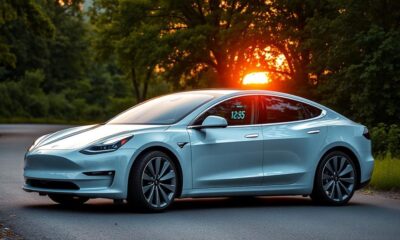
 Tesla Tuning3 months ago
Tesla Tuning3 months agoTesla Mileage: How Many Miles Can You Drive on a Full Charge?
-
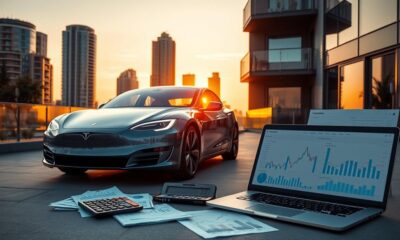
 Tesla Tuning2 months ago
Tesla Tuning2 months agoHow Much Does It Cost to Lease a Tesla? Get the Full Breakdown!
-
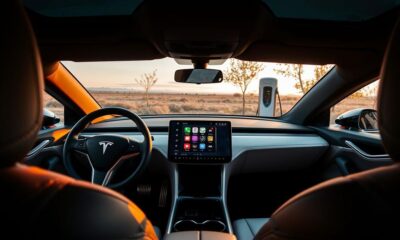
 Tesla Tuning3 months ago
Tesla Tuning3 months agoTesla CarPlay: Does Tesla Have Apple Integration?
-

 BMW Tuning3 months ago
BMW Tuning3 months agoBMW M340i Tuning Stage 2: Pushing Your Sports Sedan to the Limit






